Wildflowers
The Fryers Ridge forest is noted for the abundance and diversity of the flowering grasses, shrubs and herbs collectively known as the understorey that grow between the trees.
Wildflower season begins in late autumn and continues until early summer. Flowering times for various plants depend on the nature of the season. A warm, dry spring leads to short, early flowerings while a cool, wet spring slows things down. The lists below are a guide to some of the iconic plants that can be found in the Fryers Ridge area according to rough flowering times. Photos courtesy of Team Henderson and the Castlemaine Flora website. (Note: this website is an excellent resource for local plant identification with accurate botanical descriptions of each plant. Images used in this website are marked with a +)
Plants marked with an asterisk* are found only in the Fryers Ranges forest
MAY – JULY
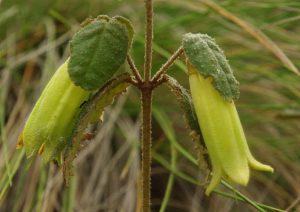
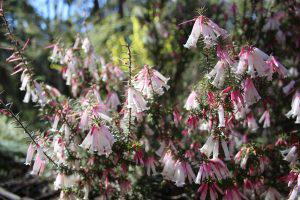
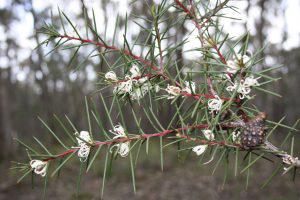
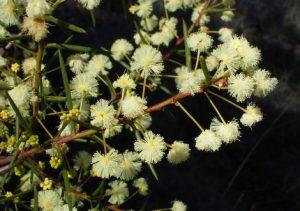
Correa (Correa reflexa)Correa (Correa reflexa)+.Medium sized shrub. Flowers emerge from between pairs of folded leaves
Common Heath (Epacris impressa)Grows in higher altitude areas of forest. Widespread around junction of Old Coach Road and Main Ridge Road
Hakea (Hakea decurrens) +Tall bushes. Leaves are long, sharp spikes
Spreading Wattle (Acacia genistifolia)+Tall bushes, spiky leaves. Long flowering period
JULY – AUGUST
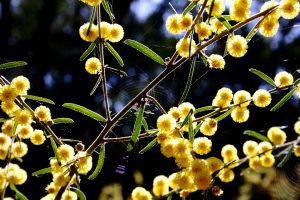
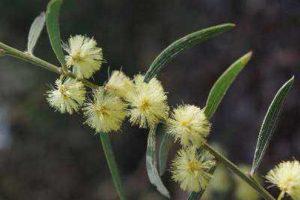
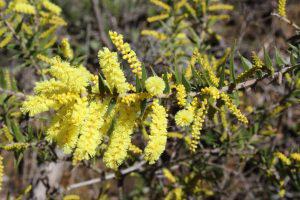
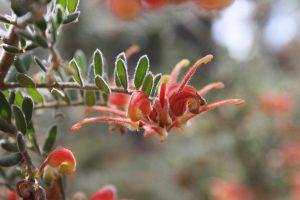
Rough Wattle (Acacia aspera)+Grows to about one metre. Spreading bushes. Leaves have a rough texture
Woolly Wattle (Acacia lanigera)Similar in form to Rough Wattle. Flowers clustered closer to stem. Smooth leaves, parallel veins
Spike wattle (Acacia oxycedrus)*.Medium to tall shrub. Showy flowers in long spikes clustered along stems. Spiky leaves. Grows in higher altitude regions of forest. Good display in upper section of Conns Track and at Old Coach Road-Main Ridge Road junction.
Downy Grevillea (Grevillea alpina). Can grow to 2 metres. Long flowering period.
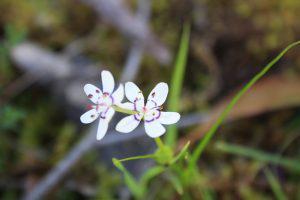
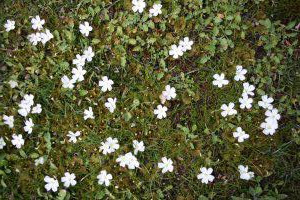
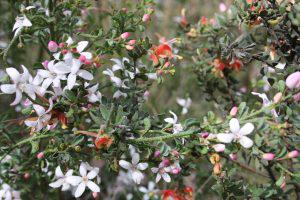
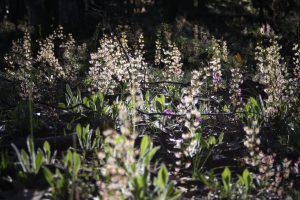
Early Nancy (Wurmbia dioica)+Small white flower with distinctive purple ring . Male and female flowers on separate plants
Scented Sundew (Drosera Whittakeri)Ground cover. Rosette of small sticky insect – catching leaves spread out on ground. Delicate white flower on short stem
Fairy Wax-Flower (Philotheca verrucosa)Small to medium sized shrub, small ovate leaves. Pink buds open to white flowers. Occasional pink form. Shown here with Grevillea
Tall Sundew (Drosera peltata). Sticky insect-catching leaves on a stem up to 20 cm tall. Pink flowers (not shown in photo)
AUGUST – SEPTEMBER
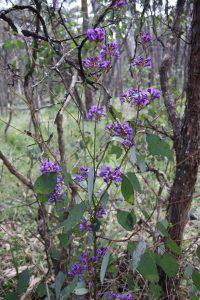
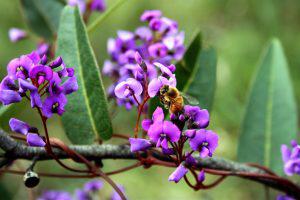
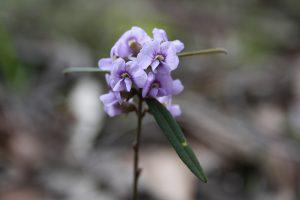
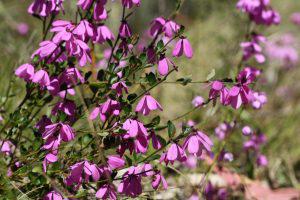
Purple Coral-pea (Hardenbergia violacea). Climbing plant with purple pea flower that can be found on the ground or in a spectacular show in a shrub or tree
Hardenbergia close up.with a visiting bee
Common Hovea (Hovea heterophylla) Low, small shrub. Pale purple pea cluster on short stem
Pink Bells (Tetratheca ciliata) Low shrub.Pink four-petaled flowers. Long flowering period
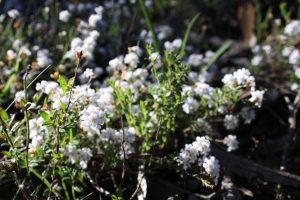
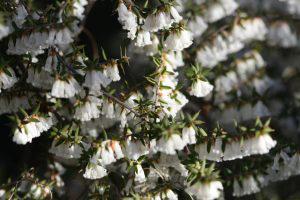
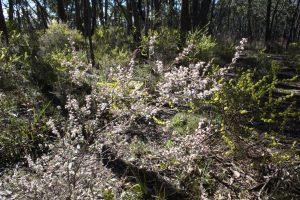

Common Beard-heath (Leucopogon virgata) Low shrub with clusters of small white trumpet-shaped flowers. Fine hairs on petals lead to the name ‘beard heath’. Flowers same form as Pink Beard-heath. Forms attractive gardens with Pink Bells in some areas.
Twin-flower Beard-heath* (Leucopohon fletcheri ..) ..subspecies brevisepala. Medium-sized shrub with showy display of parallel trumpet flowers in rows along stem. Tends to occur in higher altitude areas of forest. Prolific along Fryers Ridge Road south of junction with Old Coach Road.
Pink Beard-heath (Leucopogon ericoides) Delicate medium sized shrub with beard heath flowers. Grows in ‘gardens’ in certain areas. e.g. Steep section of No Name Track below junction with Conns Track.
Early Nancy (Wurmbia dioica) + Small white flower with distinctive purple ring. Male and female flowers on separate plants
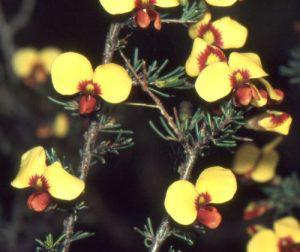
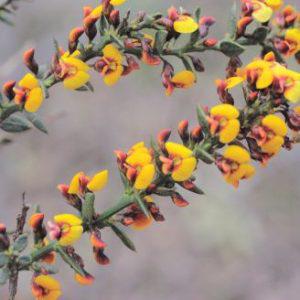
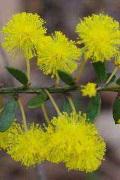
Bushy Parrot-pea (Dillwynia ramosissima) + Sparse shrub typically 1 to 1.5 metres tall. Short twiggy leaves. Yellow pea flower with a dark red to brown centre.
Gorse bitter-pea (Davesia ulicifolia). Prickly shrub with small yellow and brown flowers.
Gold-dust Wattle (Acacia acinacea) + Low shrub. Small ovate leaves.
SEPTEMBER – OCTOBER
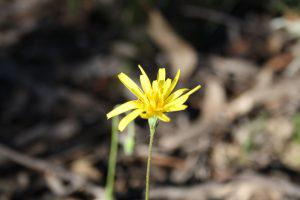

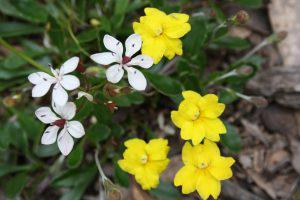
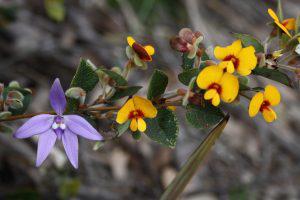
Murnong/Yam Daisy (Microceris sp.) + Daisy plant growing from tuber that was an important traditional food source for Aboriginal people. Formerly widespread, Murnong meadows were destroyed by grazing sheep. Found throughout forest. ramosissima) + Sparse shrub typically 1 to 1.5 metres tall. Short twiggy leaves. Yellow pea flower with a dark red to brown centre.
Bundled guinea-flower (Hibbertia fasciculata var prostrata) + Low to medium shrub often grows in vertical stalks, with yellow flowers up the stem.
Primrose Goodenia (Goodenia blackiara) Ground level plant with yellow flowers. Flowers late into season. Resilient in hot dry conditions. Seen here with Milkmaids.
Hill Flat-pea (Platylobium montanum subsp montanum). Small to medium sized shrub with paired ovate leaves and yellow/red pea flower. Shown here with waxlip orchid.
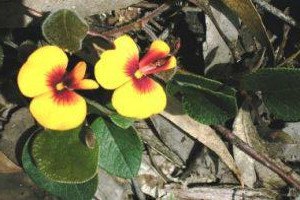
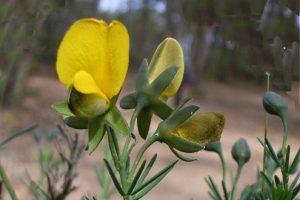
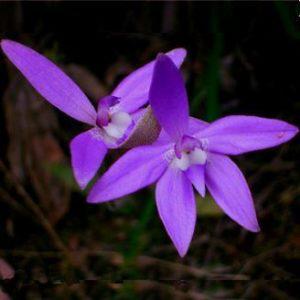
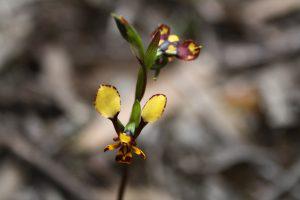
Prostrate Flat-pea (Platylobium montanum subsp. prostratum) + This is common in Fryers Forest but is evidently very restricted in its extent. A ground creeper with paired ovate leaves and large yellow and red pea flowers. Best show is on sunny days. Look out for it at the junction of Webb and Bradleys Tracks in a rich flower garden.
Common Wedge Pea (Gompholobium huegelii) + Small shrub with striking yellow pea flowers. Buds have a dark grey tinge
Waxlip Orchid (Glossodia major) + Grows abundantly in purple orchid gardens through the forest. Usually single flower head per stem.
Leopard Orchid (Diuris pardenia) One of the earlier spring orchids. Typically 10 -15 cm stalk length. Distinctive brown and yellow orchid flowers
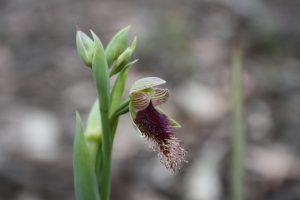
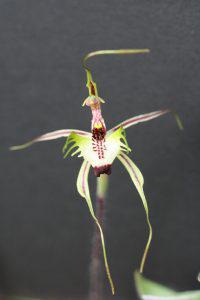
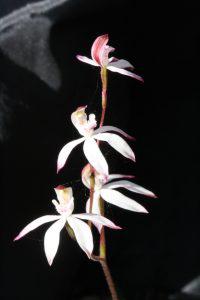
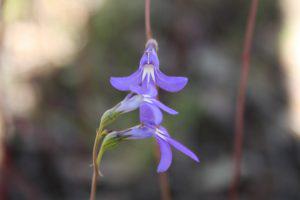
Purple Beard Orchid (Calochilu robersonii) Moderately common. 10-20 cm tall. Usually multiple flower heads per stem with one flower open at a time. Long purple bearded ‘tongue’.
Brown Clubbed Spider Orchid (Caladenia phaeoclavia) Small orchid often 15 cm tall or less in dry areas. Elaborate flower head with long ‘spider leg’ sepals.
Tall Lobelia (Lobelia gibbosa) One of the earlier orchids. A blue variety is occasionally found.
Pink Fingers (Caladenia carnea) the blue variety.
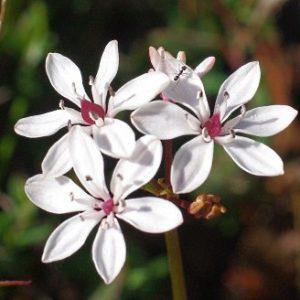
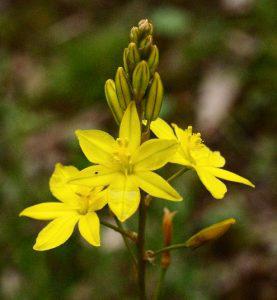
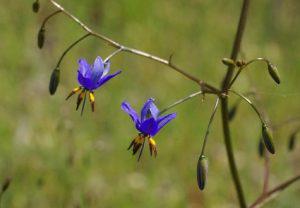
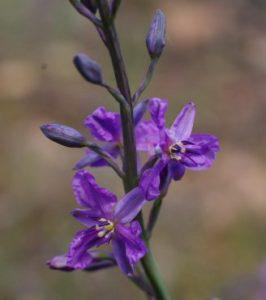
Milkmaids (Burchardia umbellata) + These plants are prolific in certain areas of the forest. Six petaled white flowers with rose calyx. Typically 10 to 15 cm tall flower stalks. The Taradale cemetery has a beautiful meadow of milkmaids in spring.
Bulbine Lily (Bulbine bulbosa)+Handsome yellow flowers in clusters at top of stem.
Black anther flax lily (Dianella revoluta) Grows in clumps throughout forest. Reed-like leaves.
Chocolate Lily (Arthropodium strictum) + Purple lily flowers with many heads per stem. Prolific in season.
OCTOBER – NOVEMBER
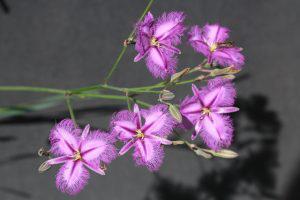
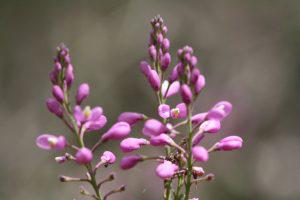
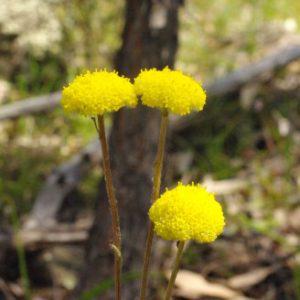
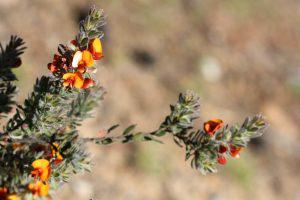
Fringe lily (Thysanotus tuberosus) An elaborately beautiful flower growing in 20-25 cm stems, usually multiple flowers per stem. Short flowering season.
Heath Milkwort (Comesperma ericinum) Purple flowering shrub which can grow to one metre. Good display near junction of Old Coach Road and Fryers Ridge Road.
Billy Buttons (Craspedia variabilis)+There are several varieties of Billy Buttons. The large pom-pom head is the most common variety.
Dwarf Bush Pea ( Pultenacea humilis)A low shrub with orange/red pea flowers clusters and soft ‘furry’ greyish-green leaf clusters. This pea makes a fine show in sections of the Fryers Ridge Road. A later flowerer.
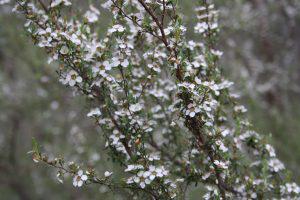
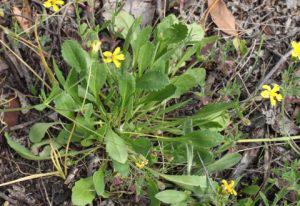
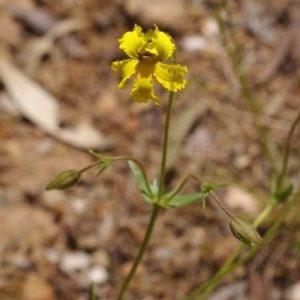
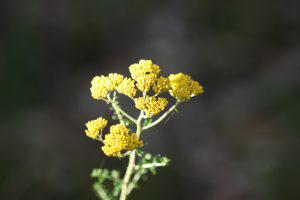
Heath tea tree (Leptospermum myrsinoides) A tall sparse shrub with fine leaves and abundant white flowers. Fussy about where it grows, there are some spectacular stands of this handsome plant to be found in the forest e.g. western end of Bradleys Track on hillside near Antonios Track.
Spur Velleia (Velleia paradoxa) + Low plant with a basal tuft of leaves.
Spur Velleia (Velleia paradoxa) + Close up.
Grey Everlasting flower (ozothamnus obcordatus) Medium sized shrub with small shiny dark green leaves and clusters of small bright yellow flowers which fade to pale grey, hence the name.
NOVEMBER – DECEMBER
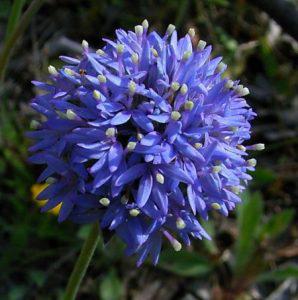
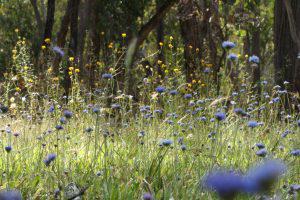
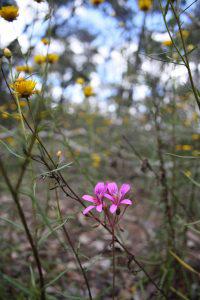
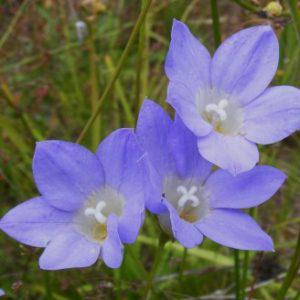
Blue Pincushions (Bunonia australis) + Brilliant blue flower clusters forming a pom-pom on a single stem. This late-flowering plant waits for the hot weather to arrive and graces the forest in large gardens, in some places. e.g. south side of Old Coach Road along the long straight hill approaching the FRyers Ridge Road, lower section of No Name Track, north side.
Blue Pincushions and Everlasting Daisies.
Magenta Stork’s-bill (Pelargonium rodneyanum)Small plant with heart-shaped glossy leaves on long stalks and distinctive magneta-coloured flowers. Image shows Stork’s-Bill and Sticky Everlasting Daisies.
Tall Bluebell (Wahlenbergia stricta) + Delicate blue bell flowers on fine stems appear in the heat and last for a remarkable length of time.
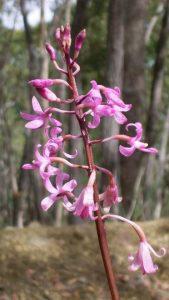
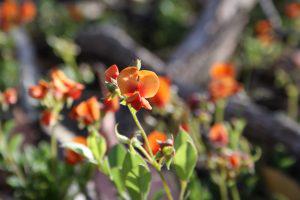
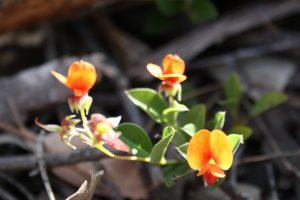
Hyacinth Orchid (Dipodium roseum)+A tall orchid with pink florets on stalks up a thick brown stem. No leaf.
Trailing Shaggy Pea (Podolobium procumbens) Trailing Shaggy Pea (Podolobium procumbens) Ground shrub growing in clumps. Mid-green glossy ovate leaves. Striking orange-yellow flowers. Occasional pink variety. A magnificent finale to the season of pea species found in the forest. Prolific on sections of Salt Water Track and Coliban Main Channel Track.
Trailing Shaggy Pea (Podolobium procumbens) Close up.
Wildflowers
The Fryers Ridge forest is noted for the abundance and diversity of the flowering grasses, shrubs and herbs collectively known as the understorey that grow between the trees.
Wildflower season begins in late autumn and continues until early summer. Flowering times for various plants depend on the nature of the season. A warm, dry spring leads to short, early flowerings while a cool, wet spring slows things down. The lists below are a guide to some of the iconic plants that can be found in the Fryers Ridge area according to rough flowering times. Photos courtesy of Team Henderson and the Castlemaine Flora website. (Note: this website is an excellent resource for local plant identification with accurate botanical descriptions of each plant. Images used in this website are marked with a +)
Plants marked with an asterisk* are found only in the Fryers Ranges forest
MAY – JULY

Correa (Correa reflexa)Correa (Correa reflexa)+.Medium sized shrub. Flowers emerge from between pairs of folded leaves

Common Heath (Epacris impressa)Grows in higher altitude areas of forest. Widespread around junction of Old Coach Road and Main Ridge Road

Hakea (Hakea decurrens) +Tall bushes. Leaves are long, sharp spikes

Spreading Wattle (Acacia genistifolia)+Tall bushes, spiky leaves. Long flowering period
JULY – AUGUST

Rough Wattle (Acacia aspera)+Grows to about one metre. Spreading bushes. Leaves have a rough texture

Woolly Wattle (Acacia lanigera)Similar in form to Rough Wattle. Flowers clustered closer to stem. Smooth leaves, parallel veins

Spike wattle (Acacia oxycedrus)*.Medium to tall shrub. Showy flowers in long spikes clustered along stems. Spiky leaves. Grows in higher altitude regions of forest. Good display in upper section of Conns Track and at Old Coach Road-Main Ridge Road junction.

Downy Grevillea (Grevillea alpina). Can grow to 2 metres. Long flowering period.

Early Nancy (Wurmbia dioica)+Small white flower with distinctive purple ring . Male and female flowers on separate plants

Scented Sundew (Drosera Whittakeri)Ground cover. Rosette of small sticky insect – catching leaves spread out on ground. Delicate white flower on short stem

Fairy Wax-Flower (Philotheca verrucosa)Small to medium sized shrub, small ovate leaves. Pink buds open to white flowers. Occasional pink form. Shown here with Grevillea

Tall Sundew (Drosera peltata). Sticky insect-catching leaves on a stem up to 20 cm tall. Pink flowers (not shown in photo)
AUGUST – SEPTEMBER

Purple Coral-pea (Hardenbergia violacea). Climbing plant with purple pea flower that can be found on the ground or in a spectacular show in a shrub or tree

Hardenbergia close up.with a visiting bee

Common Hovea (Hovea heterophylla) Low, small shrub. Pale purple pea cluster on short stem

Pink Bells (Tetratheca ciliata) Low shrub.Pink four-petaled flowers. Long flowering period

Common Beard-heath (Leucopogon virgata) Low shrub with clusters of small white trumpet-shaped flowers. Fine hairs on petals lead to the name ‘beard heath’. Flowers same form as Pink Beard-heath. Forms attractive gardens with Pink Bells in some areas.

Twin-flower Beard-heath* (Leucopohon fletcheri ..) ..subspecies brevisepala. Medium-sized shrub with showy display of parallel trumpet flowers in rows along stem. Tends to occur in higher altitude areas of forest. Prolific along Fryers Ridge Road south of junction with Old Coach Road.

Pink Beard-heath (Leucopogon ericoides) Delicate medium sized shrub with beard heath flowers. Grows in ‘gardens’ in certain areas. e.g. Steep section of No Name Track below junction with Conns Track.

Early Nancy (Wurmbia dioica) + Small white flower with distinctive purple ring. Male and female flowers on separate plants

Bushy Parrot-pea (Dillwynia ramosissima) + Sparse shrub typically 1 to 1.5 metres tall. Short twiggy leaves. Yellow pea flower with a dark red to brown centre.

Gorse bitter-pea (Davesia ulicifolia). Prickly shrub with small yellow and brown flowers.

Gold-dust Wattle (Acacia acinacea) + Low shrub. Small ovate leaves.
SEPTEMBER – OCTOBER

Murnong/Yam Daisy (Microceris sp.) + Daisy plant growing from tuber that was an important traditional food source for Aboriginal people. Formerly widespread, Murnong meadows were destroyed by grazing sheep. Found throughout forest. ramosissima) + Sparse shrub typically 1 to 1.5 metres tall. Short twiggy leaves. Yellow pea flower with a dark red to brown centre.

Bundled guinea-flower (Hibbertia fasciculata var prostrata) + Low to medium shrub often grows in vertical stalks, with yellow flowers up the stem.

Primrose Goodenia (Goodenia blackiara) Ground level plant with yellow flowers. Flowers late into season. Resilient in hot dry conditions. Seen here with Milkmaids.

Hill Flat-pea (Platylobium montanum subsp montanum). Small to medium sized shrub with paired ovate leaves and yellow/red pea flower. Shown here with waxlip orchid.

Prostrate Flat-pea (Platylobium montanum subsp. prostratum) + This is common in Fryers Forest but is evidently very restricted in its extent. A ground creeper with paired ovate leaves and large yellow and red pea flowers. Best show is on sunny days. Look out for it at the junction of Webb and Bradleys Tracks in a rich flower garden.

Common Wedge Pea (Gompholobium huegelii) + Small shrub with striking yellow pea flowers. Buds have a dark grey tinge

Waxlip Orchid (Glossodia major) + Grows abundantly in purple orchid gardens through the forest. Usually single flower head per stem.

Leopard Orchid (Diuris pardenia) One of the earlier spring orchids. Typically 10 -15 cm stalk length. Distinctive brown and yellow orchid flowers

Purple Beard Orchid (Calochilu robersonii) Moderately common. 10-20 cm tall. Usually multiple flower heads per stem with one flower open at a time. Long purple bearded ‘tongue’.

Brown Clubbed Spider Orchid (Caladenia phaeoclavia) Small orchid often 15 cm tall or less in dry areas. Elaborate flower head with long ‘spider leg’ sepals.

Pink Fingers (Caladenia carnea) One of the earlier orchids. A blue variety is occasionally found.

Pink Fingers (Caladenia carnea) the blue variety.

Milkmaids (Burchardia umbellata) + These plants are prolific in certain areas of the forest. Six petaled white flowers with rose calyx. Typically 10 to 15 cm tall flower stalks. The Taradale cemetery has a beautiful meadow of milkmaids in spring.

Bulbine Lily (Bulbine bulbosa)+Handsome yellow flowers in clusters at top of stem.

Black anther flax lily (Dianella revoluta) Grows in clumps throughout forest. Reed-like leaves.

Chocolate Lily (Arthropodium strictum) + Purple lily flowers with many heads per stem. Prolific in season.
OCTOBER – NOVEMBER

Fringe lily (Thysanotus tuberosus) An elaborately beautiful flower growing in 20-25 cm stems, usually multiple flowers per stem. Short flowering season.

Heath Milkwort (Comesperma ericinum) Purple flowering shrub which can grow to one metre. Good display near junction of Old Coach Road and Fryers Ridge Road.

Billy Buttons (Craspedia variabilis)+There are several varieties of Billy Buttons. The large pom-pom head is the most common variety.

Dwarf Bush Pea ( Pultenacea humilis)A low shrub with orange/red pea flowers clusters and soft ‘furry’ greyish-green leaf clusters. This pea makes a fine show in sections of the Fryers Ridge Road. A later flowerer.

Heath tea tree (Leptospermum myrsinoides) A tall sparse shrub with fine leaves and abundant white flowers. Fussy about where it grows, there are some spectacular stands of this handsome plant to be found in the forest e.g. western end of Bradleys Track on hillside near Antonios Track.

Spur Velleia (Velleia paradoxa) + Low plant with a basal tuft of leaves.

Spur Velleia (Velleia paradoxa) + Close up.

Grey Everlasting flower (ozothamnus obcordatus) Medium sized shrub with small shiny dark green leaves and clusters of small bright yellow flowers which fade to pale grey, hence the name.
NOVEMBER – DECEMBER

Blue Pincushions (Bunonia australis) + Brilliant blue flower clusters forming a pom-pom on a single stem. This late-flowering plant waits for the hot weather to arrive and graces the forest in large gardens, in some places. e.g. south side of Old Coach Road along the long straight hill approaching the FRyers Ridge Road, lower section of No Name Track, north side.

Blue Pincushions and Everlasting Daisies.

Magenta Stork’s-bill (Pelargonium rodneyanum)Small plant with heart-shaped glossy leaves on long stalks and distinctive magneta-coloured flowers. Image shows Stork’s-Bill and Sticky Everlasting Daisies.

Tall Bluebell (Wahlenbergia stricta) + Delicate blue bell flowers on fine stems appear in the heat and last for a remarkable length of time.

Hyacinth Orchid (Dipodium roseum)+A tall orchid with pink florets on stalks up a thick brown stem. No leaf.

Trailing Shaggy Pea (Podolobium procumbens) Trailing Shaggy Pea (Podolobium procumbens) Ground shrub growing in clumps. Mid-green glossy ovate leaves. Striking orange-yellow flowers. Occasional pink variety. A magnificent finale to the season of pea species found in the forest. Prolific on sections of Salt Water Track and Coliban Main Channel Track.

Trailing Shaggy Pea (Podolobium procumbens) Close up.
SUMMER
Most flowers disappear with the onset of summer heat, although Bluebells and Stork’s-Bills can still be found in January and even February, along with the Sticky Everlasting Daisies.
Wildlife
FOR INJURED WILDLIFE PLEASE CALL WILDLIFE VICTORIA ON 1300 94535
Taradale is home to a diverse community of indigenous fauna who enjoy the large areas of regenerating native forests that surround the valley.
Visitors can expect to see kangaroos, particularly in late summer and early spring and sometimes the more reclusive wallabies, koala or echidna. Gliders, possums, antechinus, bats, water rats, platypus and the eastern pygmy-possum are all found, if not frequently seen in the area.
Tiger, Brown and Copperhead snakes are common and the eastern small-eyed snake has been recorded at Taradale. Other local reptiles include blue tongue lizards and skinks.
On a warm evening a diverse chorus of frogs, toadlets, froglets, toads and bullfrogs fill the night – daytimes are characterised by the constantly changing song of the varied birdlife found in the area with more than 142 species recorded locally.
The rare swift parrot may be seen and there is an active program to support and record numbers of the endangered brush tailed phascogale.
For more information about wildlife in the Taradale area and box-ironbark forests generally please visit the Friends of the Box Ironbark Forests and Connecting Country.
Conservation Reserves
Taradale lies between the Fryers Ridge and Taradale Nature Conservation Reserves. These reserves, and nearby pockets of land are part of the 17% of remaining box ironbark forests that once stretched in a broad band across north central Victoria.
Box ironbark forests and woodlands are dominated by red ironbark, yellow gum, red box and grey box trees with an understory of shrubs, annual plants and grasses. In spring the ground is carpeted with a spectacular display of wildflowers.
It is believed that, as a result of habitat loss, 350 box-ironbark plant and animal species are now threatened. The danger to these species is being addressed by the creation of dedicated public reserves and programs such as Connecting Country. Connecting Country works with private landholders to build habitat corridors and encourage and monitor the progress of threatened species.
For information about what activities you can enjoy at these reserves click the link to Parks Victoria.
